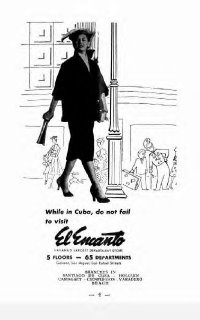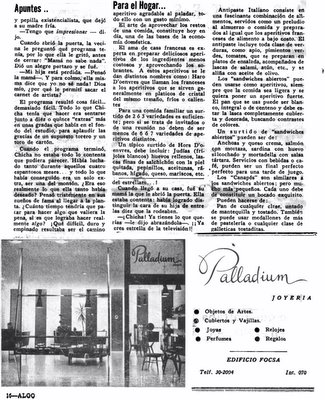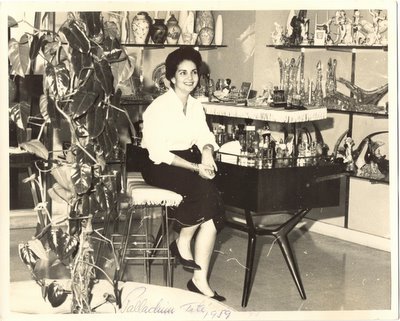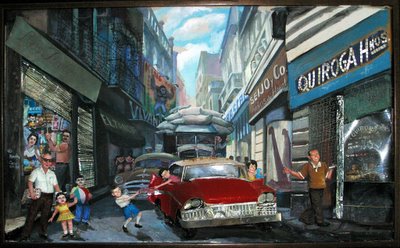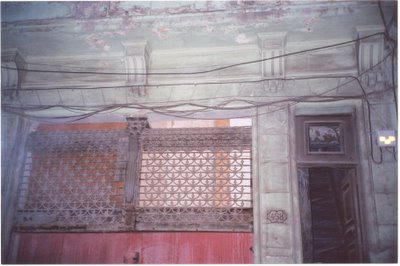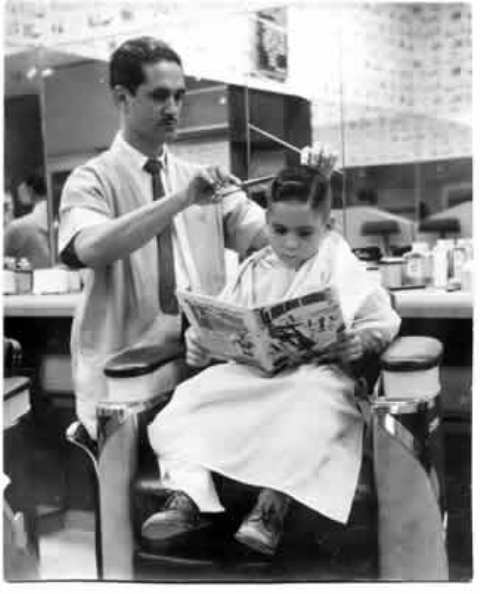Perhaps for the benefit of those readers who never saw the "Back to the Future" films, and wonder what the heck a "Delorean" is, a picture - worth 1000 words, as has been said, is in order.

-- But now, let us pretend, letting our imagination fly, since in fact DeLoreans cannot...and are not to be found new either, since no longer manufactured...this magic mode of transport has broken down and because, in early 20th Century Havana, there are no dealers to fix it, our time travelers must find contemporary ways to get around.
Decisions, decisions. Should we travel by train or trolley car? If we take the Iron Horse, we must head to Villanueva station, pictured here. Our narrator, Pedro Pablo Peralta, annotated the photograph "Villanueva station (today Capitol)." Unfortunately when "today" is or was, cannot be determined - perhaps sometime during the 1920's.

Here is a closer look at Villanueva station - to the right of the station building, altough not seen very well, is the Centro Gallego. The Centro Gallego, to which my father and many on his side of the family were later to belong, was a club, more than that, actually, which was a gathering place for the many gallegos who made Havana their home.
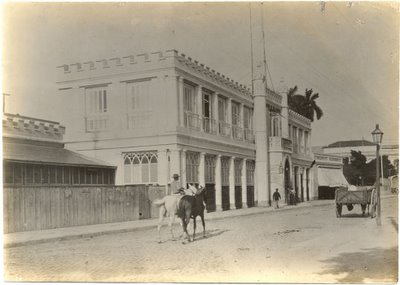
Later, the Cuban Capitolio (the Capitol), or seat of government, was to be built in this location. Hence Pedro Pablo's note regarding this site, "today Capitolio." You can see why it came to be called the Capitolio - it is built in the same style as the US Capitol building. The Centro Gallego can be better seen in the postcard, as well as the Paseo del Prado, a beautiful thoroughfare.

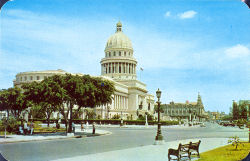
(postcard image from Cubacollectibles.com)
If we had money to buy the fare, our travelers could hop onto a tram or trolley at Villanueva or other stations throughout the city. The fare was 5 cents, from 1901 onwards, and continued to be the same into the 1920's. The rail lines and the trolley cars were built and operated by Havana Electric Railway Company, or "HER." Yes, her tram, and his too.
Our tram might have taken us to San Lazaro and Belascoain streets, seen here. The tram, called "La Maquinita," or "The Little Machine" by Pedro Pablo, took you to the Vedado neighborhood. He writes: "To the right, 'Las Cuevas (The Caves)' cafe, where the bus to El Carmelo stopped." Obviously, there later was a bus stop at the cafe, where no doubt waiting passengers would enjoy a little cafe Cubano while waiting for their "guagua." Was the "guagua," Cuban slang for bus, on time?

Should we have required lodging at the "Hotel de Guinea," we could have gotten there by horse-drawn trolley. "La Maquinita," on the other hand, was steam-powered.
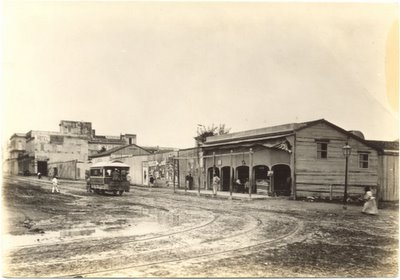
The photograph is captioned: "Zulueta, Colon (streets) - stop for trolley cars going to Vedado." So, if we needed to find lodging at the Hotel de Guinea, we had to make sure we took the horse-drawn trolley to Zulueta and Colon streets. Simple, isn't it?
To be frank, the hotel looks a little seedy, but actually better than many of the crumbling structures in the Havana of today...unless, of course, you are a foreign tourist, in which case you get the good stuff. Perhaps today's Habaneros would be grateful for a room at the Hotel de Guinea...and a horse-drawn trolley to get them there.
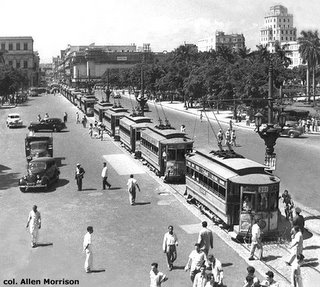
The photo is of Calzada (or thoroughfare) de La Reina - literally, the "Queen's Way." It dates to around 1947 - so a time traveler, whether from 1901, 2006, or 1947 would have no trouble finding an available trolleycar - as long as you had the fare, of course. Perhaps we could ask one of the motorists in one of the classy 40's cars to give us a ride? I think that would beat wheelin' in a DeLorean, any day.
And to give credit where credit is due, this crisp image comes from a wonderful website dedicated to the Cuban tramway system, created by a Col. Allen Morrison - it is well worth exploring if transportation is a subject of interest to you.
The Tramways of Havana (La Habana) BY Allen MorrisonOf course, you could always get around by "guagua" - as you already have learned, that's the Cuban slang term for bus. You know, that big vehicle with wheels driven by characters like Ralph Kramden. Since father began to use the bus to get around very early in his life, and since he seems to remember everything - whereas sometimes I can't seem to remember where the (censored) I put the car keys...asked him how much it cost to ride the bus in "his time." Well, the fare was also 5 cents. He added that the fare did not change for many, many years, except for the time when an additional one cent "bridge crossing fare" was imposed. "If the bus route crossed the Almendares river bridge on 23rd street, traveling from Havana to the Marianao suburb, Kohly, and places like that, then you paid the extra penny fare. This was kind of a back-door tariff imposed when, as a result of University of Havana student protests, the bus company, Cooperativa de Omnibus Aliados (Cooperative of Allied Bus Companies) failed in raising the general fare." He still remembers taking the "route 30 bus, at 17 and L streets, when I needed to go downtown." That would be to "La Habana Vieja," or "Old Havana."
The things you can learn from your parents, huh? That is, if you listen. Children: listen to your parents...and make sure you get on the right bus. Come to think of it, I still remember the number of my school bus when I attended Baldor School or Academy: Number 7. Not bad...I may yet even remember where I laid the car keys.
The Cooperativa Omnibus Aliados - known as "COA" - buses I too recall, since the pleasures of riding these conveyances, and enjoying the unforgettable smell of diesel fumes, your - at the time - pint-sized blogger was not to be denied. He was, usually unwillingly, dragged to Old Havana for some, in his opinion, unnecessary shopping expedition with mother, or an aunt or grandparent, and COA was only too happy to take their 5 cent fare. There were fare takers in each bus, who, if I recall correctly, issued little tickets upon payment. Kids on bicycles would usually secure "instant diesel power," by latching on to the buses with one hand, and letting the bus do the work - an obviously dangerous practice, which I was admonished never to think of doing, under pain of death. I do not know if this sage advice would have been followed, as we left Cuba before I was old enough to try this.
And this is what the buses looked like, to that kid, and to the other kids in Havana back in the 50s - the diesel ones, and the electric ones -

Photo from "Carteles" magazine, Sept 18, 1949 - by way of Col. Morrison's "The Tramways of Havana." This is actually one of the electric buses, which drew power from overhead wires; the diesel-powered ones were similar, if not identical. There were British Leyland buses too. These were white. Dad said they were nicknamed "nurses" because of the white color, which I remember was more of a dirty gray-white due to accumulated diesel soot. To hide the dirt, perhaps they should have been done in black, but then probably folks would not have wanted to ride - would have looked too much like giant, wheeled hearses...
And bus company inspectors would have ensured - or at least tried - things were as they should be - this would have been the job of unknown Inspector Number 725, whose COA badge is depicted. The image is from Cubacollectibles.com
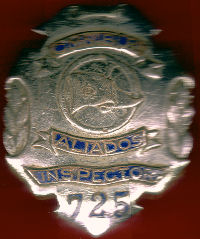
Of course, if one did not have train, or trolley/tram, or bus fare, or a car - unlikely our time travelers would have even seen a motorcar in Havana around 1900 - one could do what people have done since time immemorial: WALK. So, we head down to Calzada del Vedado, seen in our next image.

A "calzada," according to the Royal Academy dictionary, is a "cobblestoned way or road, comfortable due to its width." Well, wouldn't think it was comfortable because it was soft as a mattress. 'Cause obviously it would not be, nor would it be very comfortable for your feet. I see no cobblestones in Calzada del Vedado, just packed dirt. No doubt, by the 1950's it was nicely paved, and you could ride comfortably in, say your '57 Chevy Bel-Air, or Corvette, or Isetta, Prefect, MG, Austin, Buick, VW Beetle, Morris Minor, Renault, Cadillac, Pontiac, Studebaker...OK! Enough already! I'll do a separate post later on the cars of Havana.
Now if you were enrolled in school, in those very early days you would probably have walked there. No doubt some of you readers have heard family stories about how "your father had to walk three miles in the snow to get to school (obviously not in Cuba!)" or your "tio (uncle) Juan had to lug his books 5 kilometers to school over a hard, cobblestoned calzada!" However, there no doubt were other alternatives, such as the one seen in the photograph, the oxen-powered 2-wheeled school cart. Well, in fact it is unlikely the quaint cart was actually being used to transport the children seen on it to the "Escuela Municipal de Ninos," or "Children's Municipal School" building behind them. This vehicle is the typical country conveyance, used by Cuba's "peasants" - no disrespect meant by use of the term - or "guajiros" to transport their harvest, building materials, other goods, as needed. The equivalent of your pick-up truck or rig today, no oxen under the hood, but instead a few "horses."

The photo is annotated "Calzada de Infanta (Royal Way)." And where did this Royal Way lead? To the University of Havana, here depicted in this postcard from the 1920's. Our "guajiro" pupils could later follow the Royal Way to university. Unfortunately, a certain sinister character also went to said university...one wonders sometimes if higher education in fact is a civilizing influence. Perhaps it teaches barbarians how to hide their true character, and to excel at being cunning, being artful liars.

Postcard from Hilda's Postcard Museum - cubalabella.net; suggest you take a look as it is well worth it. There is a treasure trove of old Cuban postcards to be enjoyed there.
Our travelers by now are getting a little restless and tired; all that walking, you know. If they find themselves a little corner coffee stand, they can revive themselves with some good, sweet, strong, cafe cubano. However, they manage to get on another horse-drawn trolley and cross the bridge - the "Puente de Agua Dulce," that is - literally the "Fresh or Sweet Water Bridge."
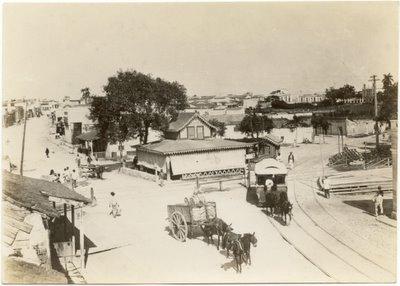
Later, the horse-drawn trolley or tram on this route was replaced by an electric-powered one. To quote from Col. Morrison's website: "By 1915, United Railways operated electric vehicles with trolley poles on five routes: from the corner of Zanja and Galiano streets to Marianao, from Central Station to Guanajay, Rincon and Guines, and from Agua Dulce to Naranjito. It also operated local tram services in Marianao and battery-powered trams from Rincon to San Antonio de los Banos. And it controlled the electric streetcar system in Guanabacoa, which ran a line west to Agua Dulce." Now you know the Sweet Water Bridge...led to the town of Sweet Water, or Agua Dulce. And thanks to the electrification of the trolleys, horse poop pick-up patrols were no longer needed - which no doubt was easier on passengers' noses.
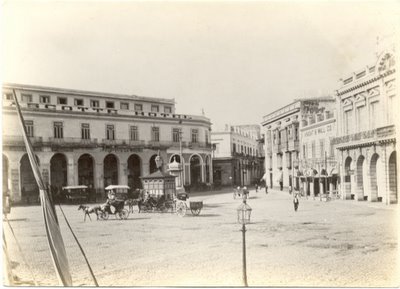
Perhaps our time-travelers decided to cut short their stay at the Hotel De Guinea. "Charming and full of character," they might have piously fibbed to the good propietor, "but we would like to know another part of your wonderful city, and must find suitable lodging." So they find themselves a carriage, which takes them to "Plazoleta de Luz," or "Little Plaza of Light," where they find lodging at the prestigious Ascotte Hotel. And if by now their shoes are worn from all the walking, they will find a shoe store and shoemaker, conveniently located at street level in their prestigious digs, the "Peleteria La Marina," or "Marina Shoe Store," marina here referring to naval (not navel!) matters. Why that name for a shoe store? What has that got to do with the sea, ships, naval matters indeed? You'll see shortly.
And what sort of store - if a store or business - was "Knight and Wall Co," across the hotel? It appears Knight and Wall was a general store, where the travelers could have shopped for necessaries - long johns, perhaps? Do you know what long johns are? Maybe it was too hot in Havana to wear them, but then again, you have seen men in suits walking about in these quaint photographs, under the tropical sun, no doubt sweating and wondering when fashion will become practical. The era of Bermuda shorts and other casual, practical attire for the tropics is still decades away.
Back to Knight and Wall. How does your blogger know it was a general store? Well, to confess, there is no ironclad certainty. But curiosity awakened, some searching was done, in the course of which a Knight and Wall was in fact found. The company was based in Tampa, Florida, in the 1880's. Now we can put two and two together, with a bit of logic and common sense thrown in. After all, this is not Mainstream Media. By the 1880's there were already strong connections between Tampa and Havana, as Tampa was home to a sizable colony of Cuban exiles and expatriates. Funny how many times Cubans have exiled themselves in Florida - well, actually, not funny at all. But thank God for the Sunshine State, geographically and mercifully reaching out as if a life-saving raft for Cuban victims of political capsizings...anyway, it makes perfect sense that Knight and Wall of Tampa, a general goods store, would seek to broaden its market by opening a branch - or branches - in Cuba, given the natural geographic and cultural connections involved. This would probably have taken place after 1898. How long they remained in business, in Tampa and/or Havana, is unknown. Perhaps those of you interested in commerce, retailing, cultural connections, geography, Tampa, Florida, Havana, Cuba, will be tempted to weave your way through the web and find some more nuggets of knowledge on the subject. You might want to start here; you may have to read carefully to find out where Knight and Wall fits in the scheme of things, but that is half the fun of research, isn't it? Hint: Look around the widow's photograph.
THE LIFE AND CAREER OF PERRY GREEN WALLFrom the Plazoleta de Luz, we would walk or take a carriage to the nearby "Muelle de Luz" - "Pier of Light." Now you see the connection between this and the shoe store name. The pier is close to Plazoleta de Luz. So the owner of the shoe store was thinking about the sea, the pier, marine things, when he named his business. That is my theory, anyway. Perhaps it is full of holes, and will sink for lack of proof. Evidently our imaginary friends have decided to leave Havana by ship. If this was the 1950's, they could have loaded their DeLorean on the Havana-Key West ferry, so as to have "wheels" in Florida. We took our '55 Chevy Bel-Air to Key West at least once - believe that was in 1958. The details of said trip will be saved for another post down the road. Stay tuned.

If the time-travelers had hung around a few years longer, they might have enjoyed yet another mode of transportation around Havana and its environs - well, truth be told, passenger airships never flew out of Cuba. For that, we had wonderful airplane service from Cubana de Aviacion, Aerovias "Q," Pan American Airways, Iberia, and others.

(Graf Zeppelin postcard from lindbergh-aviation.de)
The warped, evil mind of your blogger is at it again. You see, the old, moldy "pharaoh of Havana" has only done one thing well, to my thinking, the past 46 years: spew vast quantities of methane gas out his mouth during his endless, ramblin' and babblin's speeches. Now, given the difficulties Habaneros face these days in securing suitable and reliable transportation, would it not be feasible to build a fleet of airships similar to the Graf Zeppelin of 1938, and have el babbler fill the gas cells with his self-generated methane?? Think of the possibilities!
Failing in that, perhaps he should be stuffed with a Graf Zeppelin-sized gas bag, which when filled with his own emissions, would make an interesting parade float, perhaps to be entered in the famous Macy's Thanksgiving Parade. Why not? El gasso has been to New York before. This would beat the sight of a flyin' DeLorean, any day. And perhaps at the end of the parade, someone would stick a large pin through the green, moldy gas bag, deflating and silencing it, once and for all. Admittedly, the stench might violate USA air pollution and air quality standards, but only for a split second...
Isn't it fun to let our imagination fly? As I said before: Stay tuned.
